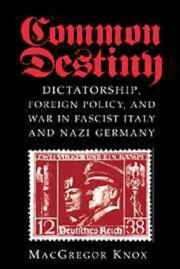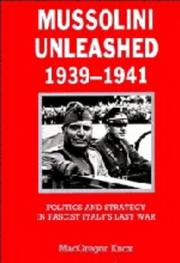| Listing 1 - 10 of 13 | << page >> |
Sort by
|

ISBN: 0521582083 0521747171 0511803907 Year: 2000 Publisher: Cambridge Cambridge University press
Abstract | Keywords | Export | Availability | Bookmark
 Loading...
Loading...Choose an application
- Reference Manager
- EndNote
- RefWorks (Direct export to RefWorks)
This book offers a genuinely comparative analysis of the dictatorships that launched the Second World War: their origins, nature, dynamics, and common ruin. It seeks to understand their similarities and differences historically, without recourse to failed generic concepts such as 'Fascism.' The result is an unconventional and compelling analytical overview from territorial unification in the 1860s to national catastrophe in 1943/45 that places Fascism and Nazism firmly in the tradition of revolutionary mass politics inaugurated in the French revolution. Set within that overview are three chapters that interpret and explain Mussolini's poorly understood foreign policy and the character and performance of the military instruments upon which Fascist and Nazi success chiefly depended - the Italian and German armies. The chapter on the German army and the conclusion - which dissects the causes of the notable disparities between the two dictatorships in expansionist appetite, fighting power, and staying power - argue that a unique synthesis of Prusso-German military tradition and Nazi revolution prompted Germany's fight to the last cartridge in 1944-45.
Fascism --- -National socialism --- -Nazism --- Authoritarianism --- Nazis --- Neo-Nazism --- Totalitarianism --- World War, 1939-1945 --- Neo-fascism --- Collectivism --- Corporate state --- National socialism --- Synarchism --- History --- Causes --- Germany --- Italy --- Foreign relations --- -Politics and government --- -Foreign relations --- -Fascism --- -History --- Weimar Republic --- Germanii︠a︡ --- Германия --- BRD --- FRN --- Jirmānīya --- جرمانيا --- Nimechchyna --- Gjermani --- Federalʹna Respublika Nimechchyny --- Veĭmarskai︠a︡ Respublika --- Ashkenaz --- Germanyah --- Bundesrepublik Deutschland --- Federal Republic of Germany --- Deutschland --- Repoblika Federalin'i Alemana --- República Federal de Alemania --- Alemania --- República de Alemania --- Bu̇gd Naĭramdakh German Uls --- Kholboony Bu̇gd Naĭramdakh German Uls --- KhBNGU --- ХБНГУ --- German Uls --- Germania --- Republika Federal Alemmana --- Deutsches Reich --- Grossdeutsches Reich --- Weimarer Republik --- Vācijā --- Repubblica italiana (1946- ) --- Italian Republic (1946- ) --- Włochy --- Regno d'Italia (1861-1946) --- Iṭalyah --- Italia --- Italie --- Italien --- Italii︠a︡ --- Kgl. Italienische Regierung --- Königliche Italienische Regierung --- إيطاليا --- Īṭāliyā --- جمهورية الإيطالية --- Jumhūrīyah al-Īṭālīyah --- Італія --- Італьянская Рэспубліка --- Italʹi︠a︡nskai︠a︡ Rėspublika --- Италия --- Италианска република --- Italianska republika --- Ιταλία --- Ιταλική Δημοκρατία --- Italikē Dēmokratia --- 이탈리아 --- It'allia --- 이탈리아 공화국 --- It'allia Konghwaguk --- איטליה --- רפובליקה האיטלקית --- Republiḳah ha-Iṭalḳit --- Lýðveldið Ítalía --- Itālija --- Itālijas Republika --- Italijos Respublika --- Olaszország --- Olasz Köztársaság --- イタリア --- Itaria --- イタリア共和国 --- Itaria Kyōwakoku --- Italiya Respublikasi --- Италия Республикаси --- Italii︠a︡ Respublikasi --- Итальянская Республика --- Італійська Республіка --- Italiĭsʹka Respublika --- İtalya --- İtalya Cumhuriyeti --- איטאליע --- Iṭalye --- 意大利 --- Yidali --- 意大利共和国 --- Yidali Gongheguo --- Laško --- Nazism --- Third Reich, 1933-1945 --- Politics and government --- 1922-1945 --- 1933-1945 --- Arts and Humanities --- National socialism. --- History.

ISBN: 9780521747134 9780511613487 9780521790475 0511613482 0511014546 9780511014543 0511118937 9780511118937 9786610162376 6610162379 0521790476 1107121310 9781107121317 0521747139 1280162376 9781280162374 0511046626 9780511046629 0511157258 9780511157257 0511304420 9780511304422 Year: 2000 Publisher: Cambridge Cambridge University Press
Abstract | Keywords | Export | Availability | Bookmark
 Loading...
Loading...Choose an application
- Reference Manager
- EndNote
- RefWorks (Direct export to RefWorks)
Fascist Italy's ultimate defeat was foreordained. It was a pygmy among giants, and Hitler's failure to destroy the Soviet Union in 1941 doomed all three Axis powers. But Italy's defeat was unique; the only asset that it conquered - briefly - with its own unaided forces in the entire Second World War was a dusty and useless corner of Africa, British Somaliland. And Italy's forces dissolved in 1943 almost without resistance, in stark contrast to the grim fight to the last cartridge of Hitler's army or the fanatical faithfulness unto death of the troops of Imperial Japan. This book tries to understand why the Italian armed forces and Fascist regime were so remarkably ineffective at an activity - war - central to their existence. It approaches the issue above all from the perspective of military culture, through analysis of the services' failure to imagine modern warfare and through a topical structure that offers a social-cultural, political, military-economic, strategic, operational, and tactical cross-section of the war effort.
World War, 1939-1945 --- Fascism --- European War, 1939-1945 --- Second World War, 1939-1945 --- World War 2, 1939-1945 --- World War II, 1939-1945 --- World War Two, 1939-1945 --- WW II (World War, 1939-1945) --- WWII (World War, 1939-1945) --- History, Modern --- Italy --- History --- History of Italy --- anno 1940-1949 --- Arts and Humanities

ISBN: 9780511619328 9780521878609 9780521703291 9780511355745 0511355742 0511619324 0521878608 0521703298 0511354703 9780511354700 1107183456 1281153524 051135522X 9786611153526 0511354126 0511574010 Year: 2007 Publisher: Cambridge, UK New York Cambridge University Press
Abstract | Keywords | Export | Availability | Bookmark
 Loading...
Loading...Choose an application
- Reference Manager
- EndNote
- RefWorks (Direct export to RefWorks)
To the Threshold of Power is the first volume of a two-part work that seeks to explain the origins and dynamics of the Fascist and National Socialist dictatorships. It lays a foundation for understanding the Nazi and Fascist regimes through parallel investigations of Italian and German society, institutions, and national myths; the supreme test of the First World War; and the post-1918 struggles from which the Fascist and National Socialist movements emerged. It emphasizes two principal sources of movement: the nationalist mythology of the intellectuals and the institutional culture and agendas of the two armies, especially the Imperial German Army and its Reichswehr successor. The book's climax is the cataclysm of 1914-18 and the rise and triumph of militarily organized radical nationalist movements - Mussolini's Fasci di combattimento and Hitler's National Socialist German Workers' Party - dedicated to the perpetuation of the war and the overthrow of the post-1918 world order.
Totalitarianism. --- Fascism --- National socialism --- Nazism --- Authoritarianism --- Nazis --- Neo-Nazism --- Totalitarianism --- World War, 1939-1945 --- Totalitarian state --- Collectivism --- Despotism --- Dictatorship --- History. --- Causes --- Arts and Humanities --- History

ISBN: 051109681X 0521338352 Year: 1986 Publisher: Cambridge : Cambridge University Press,
Abstract | Keywords | Export | Availability | Bookmark
 Loading...
Loading...Choose an application
- Reference Manager
- EndNote
- RefWorks (Direct export to RefWorks)

ISBN: 0521239176 Year: 1982 Publisher: Cambridge Cambridge University Press
Abstract | Keywords | Export | Availability | Bookmark
 Loading...
Loading...Choose an application
- Reference Manager
- EndNote
- RefWorks (Direct export to RefWorks)
Multi
ISBN: 9780511803901 9780521582087 9780521747172 Year: 2000 Publisher: Cambridge Cambridge University Press
Abstract | Keywords | Export | Availability | Bookmark
 Loading...
Loading...Choose an application
- Reference Manager
- EndNote
- RefWorks (Direct export to RefWorks)
Digital
ISBN: 9780511619328 Year: 2007 Publisher: Cambridge Cambridge University Press
Abstract | Keywords | Export | Availability | Bookmark
 Loading...
Loading...Choose an application
- Reference Manager
- EndNote
- RefWorks (Direct export to RefWorks)

ISBN: 9780511583575 9780521239172 9780521338356 Year: 1982 Publisher: Cambridge Cambridge University Press
Abstract | Keywords | Export | Availability | Bookmark
 Loading...
Loading...Choose an application
- Reference Manager
- EndNote
- RefWorks (Direct export to RefWorks)

ISBN: 052180079X 110738561X 0511817339 Year: 2001 Publisher: Cambridge Cambridge University press
Abstract | Keywords | Export | Availability | Bookmark
 Loading...
Loading...Choose an application
- Reference Manager
- EndNote
- RefWorks (Direct export to RefWorks)
The Dynamics of Military Revolution aims to bridge a major gap in the emerging literature on revolutions in military affairs, suggesting that there have been two very different phenomena at work over the past centuries: 'military revolutions', which are driven by vast social and political changes; and 'revolutions in military affairs', which military institutions have directed, although usually with great difficulty and ambiguous results. By providing both a conceptual framework and a historical context for thinking about revolutionary changes in military affairs, the work establishes a baseline for understanding the patterns of change, innovation, and adaptation that have marked war in the Western World since the thirteenth century - beginning with Edward III's revolutionary changes in medieval warfare, through the development of modern Western military institutions in seventeenth-century France, to the cataclysmic changes of the First World War and the German Blitzkrieg victories of 1940. This history provides a guide for thinking about military revolutions in the coming century, which are as inevitable as they are difficult to predict.
MODERN MILITARY HISTORY -- 930.365 --- EUROPE -- 930.365 --- Europe --- -Military art and science --- -Military history, Modern --- Revolutions --- -Strategy --- -Military strategy --- Military art and science --- Military doctrine --- Insurrections --- Rebellions --- Revolts --- Revolutionary wars --- History --- Political science --- Political violence --- War --- Government, Resistance to --- Modern military history --- Fighting --- Military power --- Military science --- Warfare --- Warfare, Primitive --- Naval art and science --- History, Military --- #A0309HI --- United States --- -Europe --- -History, Military --- -MODERN MILITARY HISTORY -- 930.365 --- -Modern military history --- Military strategy --- U.S.A. --- Jungtinės Amerikos valstybės --- Soedinennye Shtaty Si︠e︡vernoĭ Ameriki --- Soedinennye Shtaty Severnoĭ Ameriki --- Si︠e︡vero-Amerikanskīe Soedinennye Shtaty --- Severo-Amerikanskie Soedinennye Shtaty --- Zlucheni Derz︠h︡avy --- USA --- US --- Arhab --- Ar. ha-B. --- Artsot ha-Berit --- ولايات المتحدة الامريكية --- Wilāyāt al-Muttaḥidah al-Amirīkīyah --- ABSh --- Amerika Birlăshmish Shtatlary --- ABŞ --- Amerika Birlăşmi Ştatları --- Forente stater --- Spojené staty americké --- Severo-Amerikanskie Shtaty --- Sjedinjene Američke Države --- Zʹi︠e︡dnani Derz︠h︡avy Ameryky --- Amerikai Egyesült Államok --- Yhdysvallat --- Verenigde Staten --- Egyesült Államok --- Hiwsisayin Amerikayi Miatsʻeal Tērutʻiwnkʻ --- Estados Unidos de América --- United States of America --- Fareyniḳṭe Shṭaṭn --- Artzois Ha'bris --- Estados Unidos da América do Norte --- SShA --- Soedinennye Shtaty Ameriki --- VSA --- États-Unis d'Amérique --- Vereinigte Staaten von Amerika --- Stati Uniti d'America --- Estados Unidos --- EE.UU. --- Stany Zjednoczone --- ĒPA --- Amerika Qūrama Shtattary --- Amerika Qŭshma Shtatlari --- SAD --- Saharat ʻAmērikā --- Hēnomenai Politeiai Amerikēs --- ZSA --- Mei-kuo --- Meiguo --- Mei guo --- ZDA --- Združene države Amerike --- U.S. --- America (Republic) --- Amirika Carékat --- Verenigde State van Amerika --- VS --- ولايات المتحدة --- Wilāyāt al-Muttaḥidah --- ولايات المتّحدة الأمريكيّة --- Wilāyāt al-Muttaḥidah al-Amrīkīyah --- Estatos Unitos --- Estatos Unitos d'America --- Ètats-Unis d'Amèrica --- Estaos Xuníos d'América --- Estaos Xuníos --- Tetã peteĩ reko Amérikagua --- Istadus Unidus --- Amerika Birlăşmiş Ştatları --- Amerika ka Kelenyalen Jamanaw --- Bí-kok --- Amerika Qushma Shtattary --- AQSh --- Злучаныя Штаты Амерыкі --- Zluchanyi︠a︡ Shtaty Ameryki --- Yunaeted Stet blong Amerika --- Yunaeted Stet --- Vaeinigte Staatn --- Vaeinigte Staatn vo Amerika --- Stadoù-Unanet Amerika --- Sŭedineni amerikanski shtati --- САЩ --- SASht --- Съединените щати --- Sŭedinenite shtati --- Америка (Republic) --- Amerika (Republic) --- Estats Units d'Amèrica --- Америкӑри Пӗрлешӳллӗ Штатсем --- Amerikări Pĕrleshu̇llĕ Shtatsem --- Stati Uniti --- SUA (Stati Uniti d'America) --- Unol Daleithiau America --- Unol Daleithiau --- Amerikas Forenede Stater --- Vereinigte Staaten --- Wááshindoon Bikéyah Ałhidadiidzooígíí --- Zjadnośone staty Ameriki --- Ameerika Ühendriigid --- Ηνωμένες Πολιτείες της Αμερικής --- Hēnōmenes Politeies tēs Amerikēs --- Η.Π.Α. --- Ē.P.A. --- Usono --- Unuiĝintaj Ŝtatoj de Ameriko --- Американь Вейтьсэндявкс Штаттнэ --- Amerikanʹ Veĭtʹsėndi︠a︡vks Shtattnė --- Ameriketako Estatu Batuak --- Feriene Steaten --- Feriene Steaten fan Amearika --- FS --- Stâts Unîts di Americhe --- Stâts Unîts --- Stáit Aontaithe Mheiriceá --- Steatyn Unnaneysit America --- Steatyn Unnaneysit --- S.U.A. --- Na Stàitean Aonaichte --- NSA --- Mî-koet --- 미국 --- Miguk --- Amerikayi Miatsʻyal Nahangner --- Miatsʻyal Nahangner --- Military history, Modern --- Strategy --- Military history --- Naval history --- Southern States --- Confederate States of America --- History, Military. --- Lost Cause mythology --- Military history, Modern. --- History.
Multi
ISBN: 9780511817335 9780521800792 Year: 2001 Publisher: Cambridge Cambridge University Press
Abstract | Keywords | Export | Availability | Bookmark
 Loading...
Loading...Choose an application
- Reference Manager
- EndNote
- RefWorks (Direct export to RefWorks)
Military engineering --- World history --- Europe --- United States of America
| Listing 1 - 10 of 13 | << page >> |
Sort by
|

 Search
Search Feedback
Feedback About UniCat
About UniCat  Help
Help News
News